Large Bathroom Remodel: Your Ultimate Guide
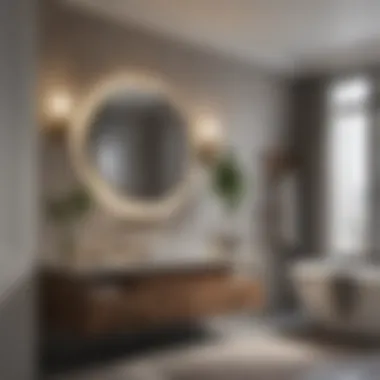
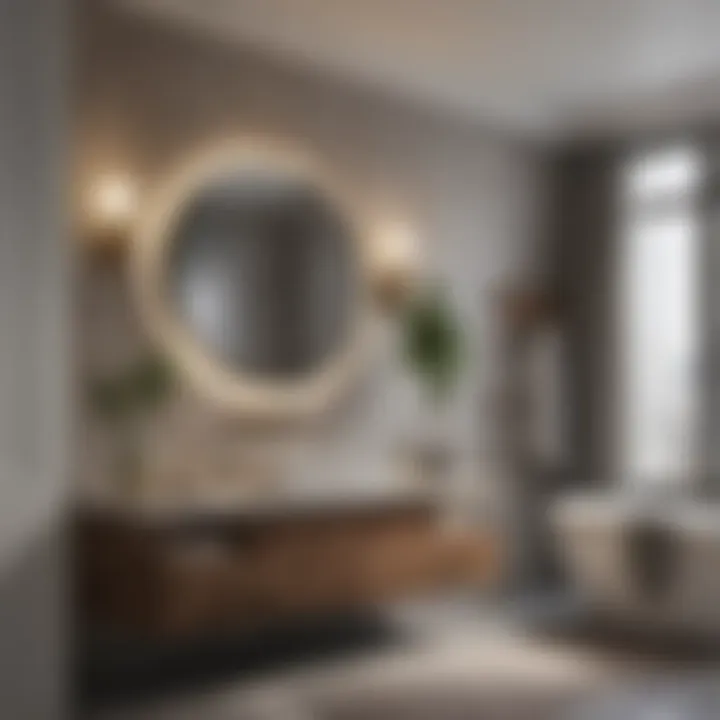
Intro
A large bathroom remodel offers an opportunity to create a personal sanctuary within your home. This transformation not only adds value but also enhances your daily routines. Understanding the process involves various stages, from conceptual planning to execution. A clear framework helps ensure that the final outcome aligns with your vision and practical needs.
Homeowners often face challenges when deciding how to best use space. Bathroom layout is critical, impacting functionality and flow. To guide you, we will explore trending styles that can dictate the overall feel of the remodel.
Moreover, color palettes play a vital role. Selecting the right colors can evoke emotions and create a style that reflects individual tastes. Throughout this guide, we will discuss essential aspects such as sourcing materials, aligning designs with today's trends, and implementing effective execution strategies.
In delving into these components, the intention is to provide clarity and assurance for homeowners. The objective is to transform an ordinary bathroom into a spacious, functional retreat that seamlessly harmonizes aesthetics with practicality.
Trending Styles
Choosing a style sets the foundation for your remodel. Two noteworthy trends are modern minimalism and cozy rustic designs.
Modern Minimalism
This contemporary approach focuses on simplicity and functionality. Clean lines, open spaces, and a lack of clutter define this style. A modern minimalistic bathroom often incorporates:
- Natural materials like stone and wood.
- Neutral colors, predominantly whites and grays.
- Sleek fixtures and integrated storage solutions.
The aim is a serene environment where form meets function. A minimalist design can make a large bathroom feel expansive and airy.
Cozy Rustic
For those drawn to warmth and charm, the cozy rustic style is appealing. This design embraces organic materials and earthy tones. A rustic bathroom might feature:
- Vintage fixtures, such as clawfoot tubs.
- Wooden elements, like beams or cabinetry.
- Warm color palettes with deep greens and browns.
Rustic areas are often inviting and relaxing, making them perfect for a personal retreat.
Both styles offer unique advantages, allowing homeowners to create spaces that resonate with their preferences.
Color Palettes
Colors can dramatically influence the ambiance of a bathroom. Choosing palettes wisely can enhance the desired aesthetic.
Calming Neutrals
Soft, neutral tones like beige, taupe, and white are timeless. They provide a soothing effect, making the space feel tranquil. The benefit of these hues is their flexibility; they can complement various styles, whether modern or rustic.
Bold Accents
For those who prefer a more vibrant expression, bold accents can create focal points. Colors like deep blues, emerald greens, or rich reds can energize a space when paired with neutral base colors. Accent walls or accessories might feature these shades, ensuring the room remains lively yet balanced.
In summary, selecting the right style and color palette is fundamental for a successful large bathroom remodel. These elements will influence not only the aesthetic but also the overall functionality of the space. The remainder of this guide will delve into additional considerations, ensuring you are well-equipped for this transformative journey.
Understanding the Needs for a Large Bathroom Remodel
A large bathroom remodel requires a deep understanding of the specific needs that motivate such a substantial undertaking. Homeowners must carefully evaluate both functionality and aesthetics to ensure the newly remodeled space meets daily requirements while also providing a desirable ambiance. Engaging with this process not just improves the immediate environment but can also enhance the overall value of the home.
This section unfolds into three critical components—functional requirements, aesthetic aspirations, and budget considerations—that are essential for strategizing a successful remodel. By dissecting each of these elements, one can address the complexities of creating a spacious and harmonious bathroom retreat.
Identifying Functional Requirements
Functional requirements are the backbone of any bathroom remodel. Homeowners must assess how they use their bathrooms daily. This includes determining needs for storage, bathing, and grooming. Here are key aspects to consider:
- Storage Solutions: Evaluate current storage issues. Will additional cabinetry or shelving resolve problems? Efficient storage minimizes clutter and impacts usability.
- Bathing Features: Do you need a bathtub, a shower, or both? Preferences vary widely. A shower can be more space-efficient, while a tub may offer a relaxing escape.
- Accessibility: Consider the needs of all household members, including elderly individuals or those with disabilities. Access to fixtures like sinks and showers may require specific designs.
Aesthetic Aspirations
Aesthetics play a significant role in redefining the bathroom space. It offers an opportunity to develop an environment that reflects personal style and creates a sanctuary. Think about:
- Color Palette: Choose colors that evoke serenity or energy, depending on your preference. Light colors can make a space feel larger, while dark tones may provide warmth and comfort.
- Design Style: Modern, traditional, or a blend of both? Aligning the design with personal style is crucial for long-term satisfaction. Research various styles and decide what resonates best with your vision.
- Finishing Touches: Elements such as faucets, light fixtures, and mirrors contribute to the overall theme. Selecting high-quality design features can heighten the emotional impact of the space.
Budget Considerations
Establishing a budget is critical yet often neglected in the early stages. A thought-out budget helps prioritize features and avoid overspending. Consider these factors when planning:
- Set Realistic Expectations: Assess what you can afford versus what you desire. Balance your needs with current market pricing for materials and labor.
- Contingency Fund: Always set aside an additional percentage (usually around 10-20%) for unexpected costs that might arise during construction.
- Cost Versus Value: Determine which upgrades add long-term value to your property. While luxury items may be appealing, focus on investments that enhance both livability and resale potential.
Planning the Layout
Planning the layout of a large bathroom remodel is a vital stage in the overall remodeling process. This element addresses how the space is structured, ensuring efficiency and comfort while meeting the needs of the users. A well-planned layout maximizes utility and can dramatically enhance one’s daily routines, turning the bathroom into a retreat.
When considering the layout, several factors must be taken into account. Each zone or area within the bathroom must be logically set to ensure ease of movement and accessibility. This gives a sense of flow and organization to the space. Also, there remains the essential aspect of available square footage, which must be utilized effectively to avoid clutter.
Maximizing Space Efficiency
Maximizing space efficiency is crucial when remodeling a large bathroom since it allows users to enjoy a room that feels spacious but also functional. When planning the layout, it is essential to assess existing fixtures, such as the bathtub, shower, sink, and toilet. Keeping these fixtures strategically can save space and eliminate unnecessary plumbing work.
To optimize the space:
- Choose wall-mounted fixtures: These can help free up floor space and create a more open look.
- Use built-in shelves: They provide storage without consuming too much square footage.
- Create clear pathways: Ensure that there is ample space between major fixtures to enhance movement.
These adjustments can transform a cluttered area into a streamlined and inviting space.
Zoning the Area
Zoning the area of a large bathroom allows the homeowner to create distinct functional spaces. This involves organizing the layout into specific zones for bathing, grooming, and storage. Establishing these areas can be as simple as using varied materials or colors for different sections.
Consider the following zones:
- Bathtub and Shower Area: This area can be enclosed or partially separated to promote relaxation and privacy.
- Grooming Station: A double vanity can cater to multiple users, helping maintain a smooth morning routine.
- Toilet Area: Ensuring privacy through partial walls or screens adds a layer of comfort.
By zoning the area, not only is functionality improved, but it also adds a touch of sophistication to the overall design.
Accessibility Features
Accessibility features in a large bathroom remodel are a must, ensuring that the space serves everyone, including those with mobility challenges. This consideration improves safety and comfort, making the bathroom usable and enjoyable for all family members.
Important elements to consider include:
- Curbless Showers: They enable easy access without obstacles, reducing the risk of slips and falls.
- Grab Bars: Installing these near toilets and in the shower adds essential support for users.
- Comfort Height Toilets and Sinks: These features can reduce strain for many people.
Including accessibility features not only enhances usability but also increases the home's overall value. This consideration demonstrates versatility in design being both stylish and practical.
"Incorporating thoughtful layout planning is the key to a successful large bathroom remodel. It is not only for aesthetics but also impacts daily living significantly."

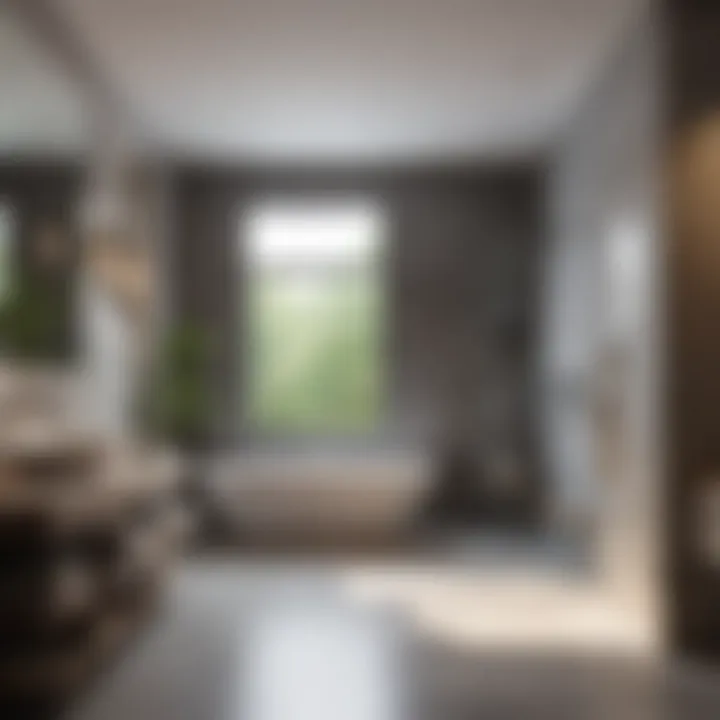
In summary, planning the layout of a large bathroom is about making calculated decisions regarding space use. By maximizing space efficiency, zoning effectively, and ensuring accessibility, homeowners can create a bathroom that combines beauty with functionality.
Choosing the Right Design Style
Selecting the appropriate design style for a large bathroom remodel is vital. It dictates the overall atmosphere of the space and can directly impact how the area will be used. A well-chosen design style can create a cohesive look, enhance functionality, and contribute to the home's overall aesthetic. When narrowing down design preferences, homeowners should carefully consider their personal tastes, the existing architecture, and future resale value.
Modern versus Traditional
Modern bathrooms tend to feature clean lines, minimalistic design, and a sleek color palette. The emphasis is often on function over form, utilizing innovative materials and technologies. Fixtures like floating vanities or frameless glass showers exemplify this style. In contrast, traditional bathrooms typically boast rich details, ornate fixtures, and classic color schemes. Elements such as wainscoting, clawfoot tubs, and wooden cabinetry characterize this design. Each style has its merits, and the choice depends on personal preference and how the homeowner envisions their bathroom.
Incorporating Trends
Trends in bathroom design can introduce refreshing elements, ensuring the space feels contemporary. Examples of current trends include spa-like features, such as rainfall showerheads or freestanding tubs, that emphasize relaxation. Earthy tones and natural materials are popular due to their calming effects. Additionally, incorporating smart technology, like automated lighting or temperature controls, can enhance the user experience. However, be cautious; trends should align with personal style to avoid a quickly dated look. A balance between trendy elements and timeless choices can result in a bathroom that remains appealing for years.
Personalizing Your Space
Personalization is key when designing a bathroom to ensure that it meets the needs of the user. Start by identifying which features are essential. Do you need a large mirror for makeup application or ample storage for towels and toiletries? Including items like personalized storage options or unique fixtures can provide a sense of ownership. Additionally, integrating colors or materials that reflect personal style will make the space feel more like home.
"A well-designed bathroom is not just about aesthetics. It's about creating a personal oasis that serves the user's needs in a functional manner."
In essence, the design style chosen for a large bathroom remodel must reflect functionality and personal taste while considering current design trends. This careful selection ensures the result is a beautiful and welcoming retreat.
Material Selection
Material selection plays a crucial role in the success of a large bathroom remodel. The right materials can enhance both the aesthetics and functionality of the space while ensuring durability for long-term use. This section explores various components of material choice, including flooring, wall treatments, and cabinetry, which are essential for creating a cohesive and stylish bathroom.
Choosing Flooring Options
Choosing flooring for a bathroom is not merely about style but also about practicality. Options like porcelain tile, which is resistant to moisture, can provide a durable surface. Vinyl flooring, another popular choice for bathrooms, offers both comfort and water resistance. Each material has distinct benefits. For example, utilizing tiles can elevate the overall design with patterns and colors, while vinyl can be easier on the feet and budget.
Consider slip resistance in your choice, especially in homes with children or elderly individuals. This can not only prevent accidents but also ensure safety in the long run. Remember to also factor in maintenance, as some materials require more upkeep than others.
Wall Treatments and Tiling
Wall treatments set the tone for your bathroom's ambiance. Tiles are a popular choice due to their versatility. Ceramic or glass tiles can add a touch of luxury and are easy to clean. They resist moisture, which is essential in a bathroom environment. Wallpaper and paint can also be considered but should be specifically designed for humid areas to prevent peeling and mold growth.
Incorporating a feature wall with diverse tiles can become the focal point of the bathroom. It’s essential to choose a color palette that resonates with your desired aesthetic while ensuring that it complements the overall design of the space.
The choice of wall treatment influences both visual appeal and practical issues like moisture control.
Cabinetry and Counter Material Choices
Cabinetry and countertops serve as functional elements while also contributing to the bathroom's style. Common materials for cabinetry include wood, laminate, and MDF. Solid wood provides durability and can be stained or painted easily. Laminate, on the other hand, can offer an affordable, stylish option with a vast array of colors and patterns.
Countertops made from granite, quartz, or marble not only enhance visual appeal but also offer durability against water and stains. Unlike laminate tops, these options are heat and scratch resistant. Choosing the right combination of cabinetry and countertops can create a harmonious look.
Benefits to Consider:
- Durability: Ensure long-lasting performance, especially in high-traffic areas.
- Maintenance: Choose materials that are easy to clean and maintain.
- Style: Select features that reflect your personal taste and complement the overall décor.
Plumbing and Electrical Considerations
When remodeling a large bathroom, the significance of plumbing and electrical considerations is paramount. These elements not only ensure that the bathroom operates efficiently but also contribute to the overall comfort and luxury of the space. Decisions made in these areas can affect everything from water flow and temperature to the availability of power outlets for appliances and lighting. Property owners often overlook these issues until they start facing problems, making it vital to prioritize these systems during a remodel.
Upgrading Plumbing Systems
Upgrading plumbing systems is an essential step in the remodeling process. Modern plumbing solutions offer various advantages over older systems. First, newer piping materials like PEX or CPVC are more resistant to leaks and corrosion, which enhances durability. This can lead to fewer maintenance issues and a longer lifespan for the plumbing work.
Homeowners should assess the existing pipes to determine if any need replacement. Additionally, it’s crucial to install fixtures that improve water efficiency, such as low-flow faucets and dual-flush toilets. This not only conserves water but also reduces monthly bills.
Benefits to Upgrading Plumbing Systems:
- Increased Efficiency: New systems work better, leading to more consistent water pressure.
- Reduced risk of leaks: Modern materials significantly cut down risks related to old, corroded pipes.
- Improved aesthetics: New fixtures and fittings can lend a modern look to the bathroom while offering improved functionality.
Electrical Upgrades for Lighting
The role of electrical upgrades for lighting in a large bathroom remodel should not be underestimated. Proper lighting can transform an ordinary bathroom into an inviting and functional space. Thoughtful placement of lights can enhance safety, visibility, and ambiance.
Upgrading to modern lighting solutions, such as LED fixtures, offers several benefits. LEDs are energy-efficient and have a longer lifespan compared to traditional bulbs. In addition, consider installing dimmer switches to allow for customizable lighting levels suitable for different activities, from skincare routines to soaking in a tub.
Considerations for Electrical Upgrades:
- Safety First: Ensure that all electrical work meets local codes. Moisture-sensitive areas require special consideration, especially outlets and switches.
- Layered Lighting: Incorporate different light types—ambient, task, and accent—to create a balanced feel.
- Positioning: Place lights strategically around mirrors for even illumination, ideal for grooming tasks.
Incorporating Smart Technology
In today's connected world, incorporating smart technology in your large bathroom remodel provides convenience and efficiency. Smart features can help manage lighting, temperature, and even water usage. Popular options include smart faucets that adjust water flow based on user preferences or motion-sensing lights that turn on as one enters the room.
Furthermore, smart mirrors with built-in LED lighting and touch controls enhance the user experience. These mirrors can provide information like time, weather, or even news updates directly from the bathroom.
Advantages of Smart Technology:
- Energy Efficiency: Monitor and manage energy consumption in real-time.
- Enhanced Control: Use apps to control various aspects of the bathroom remotely.
- Improved Comfort: Customize settings for heating, cooling, and water flow for maximum comfort.
Remodeling a bathroom is not just about aesthetics; it involves functional upgrades that enhance daily living.
By addressing plumbing and electrical considerations thoroughly, homeowners ensure that their large bathroom remodel fulfills its intended purpose of providing a functional, efficient, and pleasant environment.
Lighting Design Principles
Lighting is a crucial aspect of any large bathroom remodel. Proper lighting not only enhances the aesthetic appeal of the space but also improves its functionality. Effective lighting design can transform a bathroom into a pleasant and inviting environment, making it more enjoyable to use. It is essential to consider various elements, such as the type of light sources used, the natural light that can be incorporated, and the specific fixtures selected for this area.
Benefits of Thoughtful Lighting Design
The right lighting can create a mood, highlight design features, and ensure that tasks can be performed safely, such as shaving or applying makeup. Additionally, a well-lit bathroom gives a sense of space, making it feel larger and more open. The interplay of light and shadow can also add depth, enhancing the overall design aesthetic.
Considerations When Planning Lighting
When remodeling, one must consider the layout of the space, the types of activities performed, and the desired ambiance. Different zones within the bathroom may require different lighting solutions for a balanced effect.
Layering Light Sources
Layering light sources is an important strategy in bathroom design, consisting of three main types of lighting: ambient, task, and accent.
- Ambient Lighting: This serves as the foundational light in a bathroom, usually provided by ceiling fixtures or recessed lighting. It creates an overall brightness essential for safety and comfort.
- Task Lighting: This type targets specific areas where activities are performed. Adequate task lighting is crucial at sinks and vanity mirrors. Consider fixtures like sconces, pendants, or backlit mirrors, which ensure that tasks can be done effectively and safely.
- Accent Lighting: This highlights design features, such as artwork or architectural details. Using dimmers can help adjust the brightness level, adding flexibility to the ambiance.
Through carefully planning these lighting layers, you can enhance both functionality and aesthetic appeal.
Natural Light Integration
Natural light is an infinite resource that should not be underestimated in bathroom design. Integrating natural light can be achieved through various methods, such as windows, skylights, or glass doors.
- Windows: Placing windows strategically can brighten the bathroom and create an open feel. Consider frosted or textured glass for privacy while still allowing light in.
- Skylights: These can provide light without compromising privacy. They are especially effective in areas where conventional windows are not an option.
- Glass Features: Glass block walls or doors can offer both light diffusion and artistic appeal.
Incorporating natural light has multiple benefits. It not only reduces the need for artificial lighting but also positively impacts mood and wellbeing, making the space feel more alive.
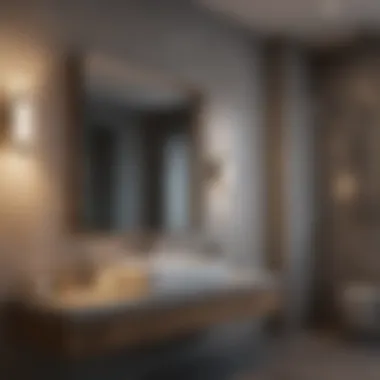
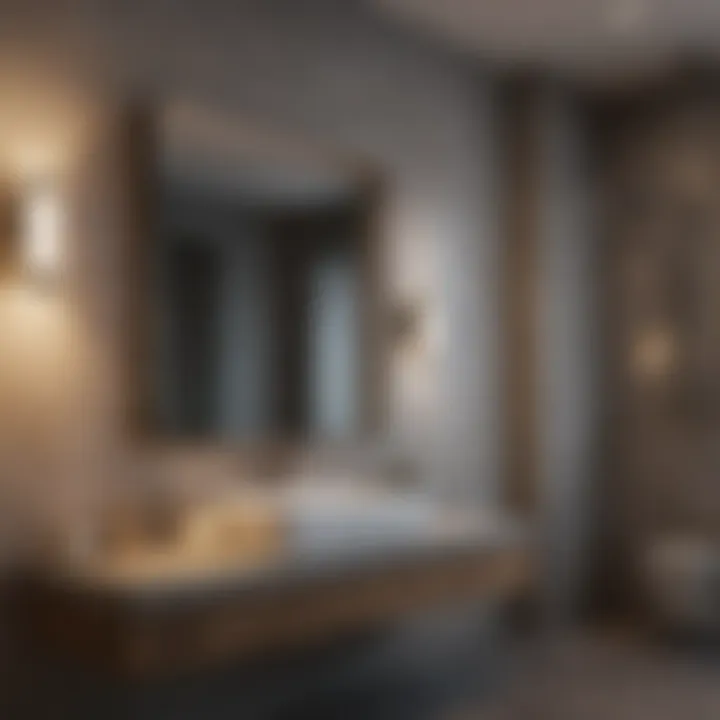
Selecting Fixtures
Selecting the right fixtures is essential to achieving your lighting goals. The choices you make can define the style and functionality of the bathroom. Below are several important aspects to consider when choosing fixtures:
- Style: The fixtures should complement your bathroom design. Whether aiming for a modern, traditional, or eclectic look, choose styles that match your overall theme.
- Size: Fixtures should be proportionate to the space. Large chandeliers in a small bathroom can be overpowering, while small wall sconces may get lost in a vast space.
- Finish: Consider the finishes on your fixtures. Options range from polished chrome and brushed nickel to oil-rubbed bronze. These should blend well with other hardware and features in the bathroom.
- Type of Bulbs: Select energy-efficient bulbs. LED lights are popular due to their long lifespan and lower energy consumption. Consider color temperature as well; warmer lights create a cozy ambiance, while cooler tones can produce an energizing effect.
Effective lighting design transforms not just the look but also the functionality of your bathroom. Select the right sources and fixtures to create a space that is both lively and practical.
By thoughtfully addressing lighting design principles, you enhance the overall impact of your large bathroom remodel. From layering light effectively to incorporating natural light and selecting appropriate fixtures, each step contributes to creating a well-lit, inviting environment.
Storage Solutions
Effective storage solutions are a cornerstone of any large bathroom remodel. As bathrooms tend to be compact areas, proper organization and storage can greatly enhance both functionality and aesthetics. An efficient layout minimizes clutter and ensures that essential items like toiletries, towels, and cleaning supplies are accessible yet discreetly stored. Investing time in thoughtful storage solutions transforms a chaotic space into an orderly sanctuary.
Maximizing Vertical Space
One way to optimize bathroom storage is by utilizing vertical space. This approach involves extending cabinetry and shelves upwards, which may often go unused. Installing tall cabinets can provide ample storage for linens, toiletries, and even seasonal items. Wall-mounted shelves also present a practical solution. They keep surfaces clear and give an illusion of spaciousness.
- Consider floating shelves which provide storage without overwhelming the space.
- Vertical storage solutions also tend to draw the eye upwards, making the room feel taller.
By maximizing vertical height, homeowners can significantly increase their storage capacity while maintaining an open feel in the bathroom.
Incorporating Built-In Units
Built-in storage units are another effective strategy for large bathroom remodels. These can be custom-designed to fit specific spaces and meet particular needs. Built-ins not only streamline the design but can also contribute to the overall aesthetic of the bathroom.
- Vanities with drawers can hide personal items while keeping everything organized.
- Recessed nooks in the walls for shampoo bottles and other essentials can save space and add a modern touch.
These units tend to integrate well with existing architectural elements and can be tailored to a homeowner's design preferences, ensuring a seamless look.
Choosing Functional Accessories
Functional accessories play a crucial role in enhancing storage solutions within a bathroom. Selecting the right accessories can vastly improve organization and usability. Here are several considerations:
- Basket systems: These can hold items like towels or cleaning supplies. They are visually appealing and functional, making them a great addition.
- Drawer organizers: These help keep items in drawers neat and easy to find, ensuring that everything has a designated spot.
- Over-the-door racks: These are perfect for additional storage without sacrificing floor space.
"Selecting the right accessories not only enhances storage but also contributes to an overall sense of order and tranquility."
By thoughtfully integrating functional accessories, homeowners can create a balanced and highly functional space that meets their daily needs.
Eco-Friendly Options
In today's world, eco-friendly options have become increasingly relevant in home design and renovation, including large bathroom remodels. Homeowners often seek to reduce their environmental impact while also enhancing the functionality and aesthetic value of their spaces. Choosing sustainable materials, implementing water conservation strategies, and integrating energy-efficient lighting not only benefit the environment but can also lead to cost savings over time. This section will explore these important topics to highlight how they can contribute to a successful and conscientious bathroom remodel.
Sustainable Materials
Opting for sustainable materials is a foundational aspect of any project focused on reducing its ecological footprint. Materials such as bamboo flooring, recycled glass tiles, and low-VOC (volatile organic compounds) paints are excellent choices. They are not only reliable but also less harmful to indoor air quality.
Using sustainable materials can add value to your home, while simultaneously helping the planet.
Benefits of sustainable materials include:
- Durability: Many sustainable materials are designed to last, which can lower the need for repairs or replacements in the future.
- Aesthetic flexibility: Eco-friendly options are available in various styles, allowing homeowners to express their personal taste alongside their commitment to sustainability.
- Health benefits: Low-VOC and non-toxic options contribute to better air quality and a healthier living environment.
Water Conservation Strategies
Incorporating water conservation strategies is essential in ensuring that your large bathroom remodel has a minimal impact on water resources. Simple choices such as installing low-flow fixtures can significantly reduce water usage without sacrificing performance. Dual-flush toilets and aerated showerheads are practical examples that combine efficiency with modern design.
Additional strategies include:
- Rainwater harvesting: This involves collecting rainwater for use in toilet flushing or irrigation, enhancing sustainability.
- Smart irrigation systems: For homeowners with gardens or landscaping adjacent to their bathrooms, these systems can conserve water effectively while maintaining beauty.
Energy-Efficient Lighting
Lighting plays a crucial role in bathroom design, serving both functional and aesthetic purposes. Energy-efficient lighting solutions, such as LED fixtures, are a smart investment. They consume significantly less energy than traditional bulbs and have a longer lifespan, leading to cost savings on electric bills.
When selecting lighting options, consider:
- Layering light: Using multiple light sources can enhance the ambiance while also meeting various needs (task, ambient, accent).
- Natural light: Whenever possible, maximize the use of natural light to reduce dependency on artificial sources. Skylights or larger windows can bring in ample light during the day.
- Smart lighting controls: Implementing motion sensors or dimmers can further conserve energy by ensuring lights are only used when necessary.
Incorporating eco-friendly options into your bathroom remodel is a proactive step towards a sustainable future. By considering sustainable materials, water conservation techniques, and energy-efficient lighting, homeowners can create a functional and attractive space that reflects both their style and commitment to the environment.
Executing the Remodel
The execution phase of your large bathroom remodel is crucial. This is where your plans become tangible results. Paying attention to this stage ensures that everything aligns with the vision you initially had, focusing on the essential elements for a smooth transition from concept to reality.
Hiring Professionals
Engaging skilled professionals is vital for a successful remodel. Depending on your project’s scale, you might need architects, contractors, and specialized tradespeople. Each of these players brings unique expertise, helping to address specific aspects of the remodel that you may not be well-versed in.
Benefits of Hiring Experts:
- Experience: Qualified professionals understand local building codes, regulations, and best practices.
- Quality Work: Specialists often yield higher-quality outcomes, as they are familiar with advanced techniques and technologies.
- Time Efficiency: Professionals can navigate the remodeling process more swiftly, minimizing potential delays and disruptions.
- Project Management: An experienced contractor can oversee the entire project, ensuring that all elements come together cohesively.
It is wise to thoroughly vet potential candidates, checking their credentials, reviews, and past projects. Don't hesitate to ask for references to gauge their reliability and standards.
Managing the Construction Process
Managing the construction process effectively is fundamental to keeping your project on track. This involves constant communication not only with contractors but also with designers and suppliers.
Key Considerations in Management:
- Regular Check-Ins: Schedule frequent updates with your team to ensure that everything is advancing as planned.
- Documentation: Keep records of agreements, contracts, and change orders. This will help in tracking expenses and progress.
- Problem-Solving: Issues often arise during renovations. Having a proactive approach to resolving these problems can save time and additional costs.
"Effective communication is the cornerstone of successful project management."
Timely adjustments and being open to recommendations can facilitate smoother operations and a more harmonious workspace.
Timelines and Schedules
Setting clear timelines and schedules is essential. Completing a bathroom remodel on time can be a significant factor in minimizing inconvenience in your home.
Developing a Realistic Timeline:
- Define Phases: Break down the project into phases such as demolition, plumbing, electrical, and finishing touches.
- Set Milestones: Establish checkpoints to measure progress, adjusting as necessary to keep the schedule aligned.
- Buffer Time: Include buffer time for unexpected delays, which may occur due to material shipments or workforce availability.
Final Touches and Decor
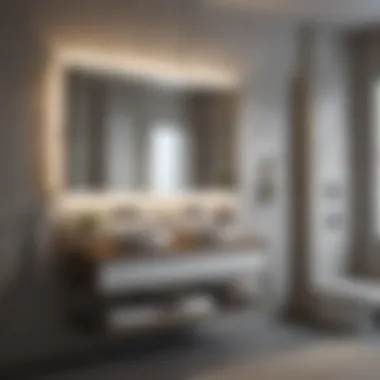
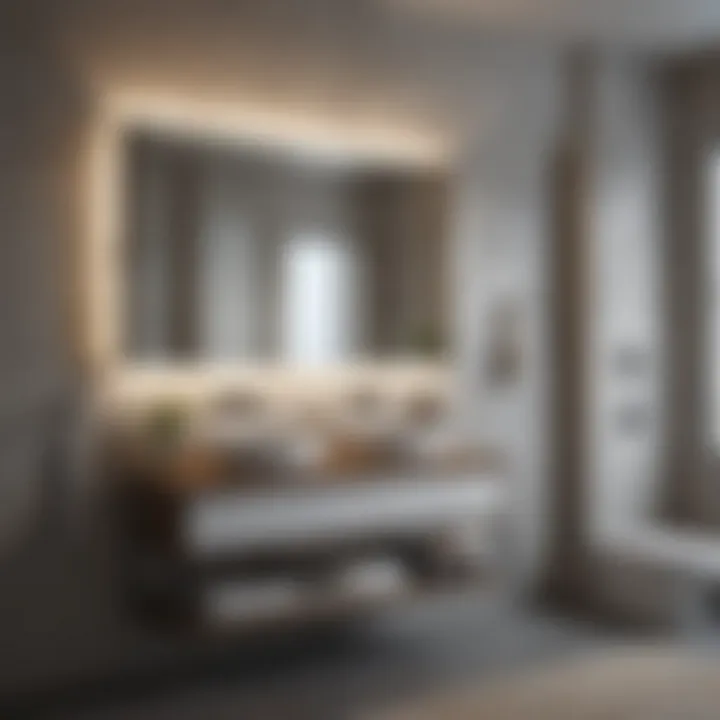
The final touches and decor are essential aspects of a large bathroom remodel. After all the heavy lifting of renovation is complete, it is these finishing elements that often elevate a functional space into a personalized retreat. The right decor and accessories not only enhance aesthetic appeal but also reflect the user's personality and preferences. This section discusses the critical components of selecting textiles, artwork, and ways to personalize the space effectively.
Selecting Textiles and Accessories
Textiles play a significant role in completing the bathroom's look. They add warmth, texture, and comfort to an otherwise utilitarian space. Choosing the right items involves understanding various aspects:
- Quality: Opt for high-quality towels, rugs, and curtains. Materials like cotton and bamboo are both absorbent and durable.
- Color Palette: Textiles should align with the overall color scheme of the bathroom. Neutral tones can create a calming effect, while vibrant colors can add a pop of excitement.
- Functionality: Consider practical items, such as non-slip bath mats, which ensure safety while also being visually appealing.
Paying attention to these details enhances the overall experience in the bathroom.
Artwork and Decorative Elements
Incorporating artwork and decorative elements is another vital aspect of finalizing a bathroom design. They serve to express individual taste and can dramatically transform the atmosphere of the space. Here are some ideas to consider:
- Framed Prints: Select artwork that resonates personally. Abstract designs or nature-inspired prints work particularly well.
- Wall Decor: Shelves with small plants or decorative trays can accentuate unused spaces, creating an inviting look.
- Mirrors: Strategically placed mirrors can enhance both lighting and the feeling of space while also being decorative.
These items can showcase personal style and provide a pleasing ambiance.
Personalizing the Space
Personalization is where a bathroom becomes more than just a functional area; it transforms into a sanctuary. To make the space uniquely yours, consider these approaches:
- Sentimental Items: Display items that hold emotional value, such as photos, travel souvenirs, or family keepsakes.
- Custom Statements: Choose monogrammed towels or custom shower curtains that add a personal touch.
- Scent Elements: Introduce candles or essential oil diffusers to create an aromatic atmosphere, enhancing relaxation.
Ultimately, the goal is to foster a sense of comfort and connection to the space, making it a retreat where one enjoys spending time.
Final touches in decor complete the remodel by adding personality and ensuring comfort.
Maintenance After Remodeling
Maintaining a newly remodeled bathroom is critical for preserving the investment made in the remodel. Once the dust settles and the final touches are added, homeowners often overlook the proactive steps necessary to keep their large bathroom looking and functioning at its best. Routine maintenance ensures that the materials and installations remain in top condition, thereby extending their lifespan and functionality.
Cleaning and Care Tips
Regular cleaning is essential for a large bathroom. Establish a cleaning schedule that fits your routine. This will help in preventing dirt buildup and maintaining the surface quality of fixtures and materials. Here are some specific tips to consider:
- Use appropriate cleaners: Choose products that suit the specific surfaces in your bathroom. For instance, use non-abrasive cleaners for natural stone surfaces to avoid scratches.
- Focus on high-traffic areas: Pay special attention to areas like the sink, shower, and toilets, as they see most use. Cleaning these spots regularly can prevent stains and mildew.
- Dry surfaces after use: Water can lead to mold and mildew growth. Wiping down surfaces after use not only helps in maintaining cleanliness but also in prolonging the life of your fixtures.
Monitoring Functionality
Routine monitoring ensures that everything is functioning as intended. This includes checking plumbing and electrical installations for any signs of wear or malfunction. It is beneficial to keep a list of parts and systems to inspect:
- Plumbing systems: Look for leaks or signs of corrosion. Check under sinks and around fixtures regularly.
- Electrical fixtures: Ensure lights and other electrical components function properly. Look for flickering lights or any unusual sounds.
- Ventilation systems: Ensure that exhaust fans work efficiently to prevent moisture accumulation, which can lead to mold.
Long-Term Upkeep Strategies
Long-term upkeep involves setting a maintenance plan that includes yearly assessments. This provides a thorough understanding of how different components of the bathroom are holding up over time. Key strategies include:
- Regular inspections: Schedule inspections every 6 to 12 months. This includes checking for wear in caulking and grouting, which can lead to water damage if neglected.
- Updating fixtures: Consider updating older fixtures and accessories. Newer products may offer enhanced performance or lower maintenance needs.
- Document changes and repairs: Keeping a log of all maintenance and repairs made allows you to track the history of the space. This is especially useful when considering future remodeling or when planning to sell the home.
Regular maintenance is crucial to ensuring that your bathroom remains a haven of relaxation and cleanliness.
By prioritizing consistent care, monitoring functionality, and implementing long-term strategies, homeowners can ensure their large bathroom retains its appeal and functionality for years to come.
Case Studies
In the realm of large bathroom remodels, case studies serve as valuable sources of real-world insights. They highlight both triumphs and setbacks in the remodeling journey, providing lessons that inform future projects. Analyzing these case studies allows homeowners to glean practical knowledge about design choices, budgetary constraints, and execution strategies. Furthermore, they illustrate the value of careful planning, thus steering homeowners clear of common pitfalls that may arise during remodeling.
Case studies encapsulate an essential narrative. They reveal how different homeowner needs and aesthetic preferences can drastically affect design outcomes. Through authentic examples, homeowners can envision potential transformations in their own bathrooms. This not only provides inspiration but also ensures a realistic expectation of the remodeling process.
Additionally, examining successful and unsuccessful projects creates a framework for understanding the best practices in large bathroom remodels. Thus, this section culminates in actionable advice, empowering readers to take informed steps in their own home improvement endeavors.
Successful Large Bathroom Remodels
Successful large bathroom remodels frequently showcase innovation and meticulous planning. Often, they feature clever use of space, top-of-the-line materials, and striking designs that resonate with personal style. For example, a bathroom that combines a modern aesthetic with functionality can significantly enhance user experience. Such spaces often feature:
- Generous storage options
- Professionally arranged layouts
- Quality finishes that withstand the test of time
One notable case involved a couple in a suburban area who transformed their outdated bathroom. They emphasized an open concept by removing barriers and employing natural light to create an airy feel. By selecting subway tiles for walls and a double vanity for convenience, they optimized both form and function. This project not only improved the daily routine but also added significant value to their home.
Beyond aesthetic upgrades, success hinges on the thoughtful integration of plumbing and electrical systems. Upgrades in these systems can prevent future issues, making long-term maintenance easier and more cost-effective.
Lessons Learned from Poor Execution
Examining lessons from poorly executed bathroom remodels offers essential learning moments. Often, these projects suffer from a lack of foresight or inadequate planning. For instance, a common issue is overestimating budget constraints or failing to research materials thoroughly.
One striking case involved a family that rushed their renovation without adequately vetting contractors. They ended up with poor craftsmanship, which caused numerous plumbing and structural issues. Such experiences emphasize the importance of:
- Diligently checking references
- Establishing clear communication channels with contractors
- Conducting thorough research on materials and costs
Homeowners are advised to conduct detailed discussions with potential remodelers, ensuring alignment in vision. Such foresight can prevent dissatisfaction and project delays due to miscommunication or misalignment.
User Experiences
User experiences in large bathroom remodels constitute an invaluable resource. They provide firsthand accounts of the ups and downs encountered during the remodeling journey. Many homeowners express that their remodeled spaces became their personal retreats, offering a sanctuary away from daily stresses.
Sharing narratives can also reveal how different features enhance usability and comfort. For instance, voices from the community recount favorable outcomes from installing heated flooring or adjustable lighting. Others highlight the efficiency gained from adding ample storage solutions to accommodate their growing needs.
Moreover, user experiences often reveal emotional and practical determinants in their remodeling decisions. Many families cite the need to create a space that caters to changing lifestyles, like accommodating children or creating a spa-like experience.
In summary, learning from the experience of others — both good and bad — can illuminate the path for your own bathroom remodeling project. This section reiterates the notion that knowledge is power and that insights derived from actual experiences can significantly enrich the remodeling journey.
The End
In this article, the conclusion serves to underline the various aspects of large bathroom remodeling. Not only does it summarize the critical steps involved, but it also emphasizes the importance of thoughtful planning and execution. Understanding the essentials of a remodel can guide homeowners in creating a space that is both functional and aesthetically pleasing.
Close attention to details such as layout, materials, and technology integration contributes significantly to the final outcome. A well-executed bathroom remodel does more than enhance the space; it adds value to the home and improves daily living experiences. Thus, a strong conclusion reinforces the need for comprehensive preparation, reminding homeowners that each phase of the process merits careful consideration.
Recap of Remodeling Essentials
Reflecting on the key elements of the remodeling process helps clarify priorities. Start with understanding your needs—both functional and aesthetic. What do you want your bathroom to look like, and how will you use the space? Clarifying these points lays the groundwork for an effective design.
Next, the planning stage involves imagining the layout that maximizes space and incorporates accessibility features. Selecting the right materials can elevate the bathroom's look—choose flooring and wall treatments that are durable, stylish, and easy to maintain.
Additionally, consider plumbing and electrical systems early on in the remodel. Any upgrades can support better functionality, particularly smart technology. Lighting design must not be overlooked; layering and integrating natural light can dramatically alter the ambiance of the bathroom.
Storage solutions further enhance usability, maximizing vertical space and potential built-ins. And remember, eco-friendly options help in sustainability and energy savings.
Inspiration for Future Projects
As you conclude the remodeling phase, think about future projects that might enhance your living space further. There is always potential for upgrades or expansions. Draw inspiration from trends that resonate with your style—perhaps looking into minimalist designs or integrating smart home features.
Additionally, keep an eye on new materials and finishes that can breate new life into your home. There is a wealth of resources available, such as discussions on platforms like Reddit and articles from sites like Wikipedia and Britannica, that cover the latest trends and innovations in home design.
By fostering creativity and openness to change, you can envision continuous improvements in your home. This mindset not only equips you for the next project but also enhances your appreciation of the current space.















